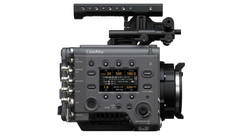Since a Steadicam operator can cover a lot of ground quickly, it felt like a great time to take a look at how the VENICE’s dual-ISO feature handles scenarios where light is abundant as well as scarce all within the same shot. (And with a gentle reminder that our Steadicam workshop students are just that, students, so we ask that negative comments about framing, etc. be left at home.)
VENICE can shoot in its "low" base ISO of 500 to a "high" base of ISO 2500. Both are true, "native" ISOs, with intermediate sensitivities being a "push" or "pull" relative to these anchors. Dual ISO functionality is becoming available on more and more cameras as the technology behind it is embraced by manufacturers. To (vastly) oversimplify how it works, think of each photo site on a dual-ISO camera's sensor as having two sets of light-sensitive hardware: one for when light is abundant, and a higher-sensitivity set for when photons are at a premium. Rather than using image processing to artificially "pump up" a camera’s sensitivity in low light, dual native ISOs allow cameras to switch to the higher sensitivity photo site "driver" on command. The result is, generally, footage that is considerably cleaner at high ISO settings than conventional approaches. Where the typical approach would, essentially, amount to raising the signal level, brightening the darker image post-capture (much as one would, for example, raise the Offset control in DaVinci Resolve to bring up under-exposed footage), the dual native ISO approach allows the camera’s fundamental sensitivity to light to be changed.
The VENICE also has another feature that makes comparisons like this easy to do. We used the portion of the shot with two people sitting at one of our cafe tables as the exposure basis; lighting this action to a T5.6 at ISO 500, getting about 88 foot-candles from a single 1x1 LitePanels Astra (window and overhead practical light also contributed to the base exposure). For each additional shot (the second at the high base of 2500 and the third at the VENICE’s highest sensitivity of 10,000), we used VENICE’s built in neutral density filtration wheel, available in single stops (huzzah!), from clear to as many as 8 stops. This allowed us to not have to change our lighting as we rolled through the different ISOs–and it gave each of our erstwhile students an opportunity to operate VENICE on a Steadicam while alternately standing in as "talent."
We’ll leave it up to you to draw your own conclusions from the test footage but suffice to say that, with the ability to handle such a wide range of illumination levels, VENICE is shaping up to be one of the most important cameras of the last several years.

















AbelCine encourages comments on our blog posts, as long as they are relevant and respectful in tone. To further professional dialog, we strongly encourage the use of real names. We reserve the right to remove any comments that violate our comment policy.
AbelCine publishes this blog as a free educational resource, and anyone may read the discussions posted here. However, if you want to join the conversation, please log in or register on our site.
We use Disqus to manage comments on this blog. If you already have a Disqus account registered under the same email as your AbelCine account, you will automatically be logged in when you sign in to our site. If not, please create a free account with Disqus using the same email as your AbelCine account.